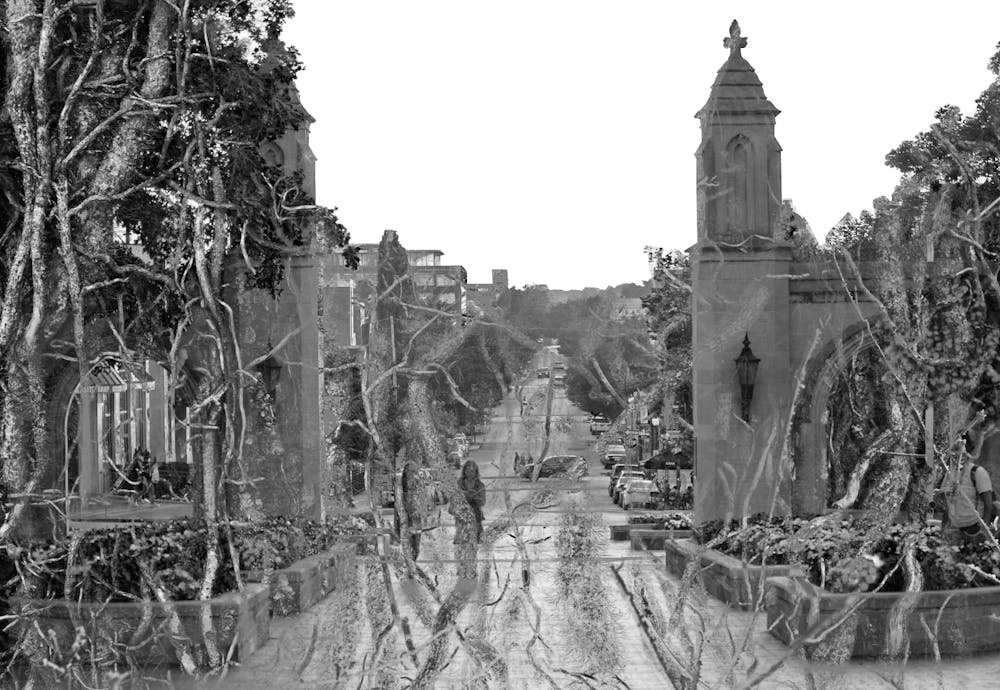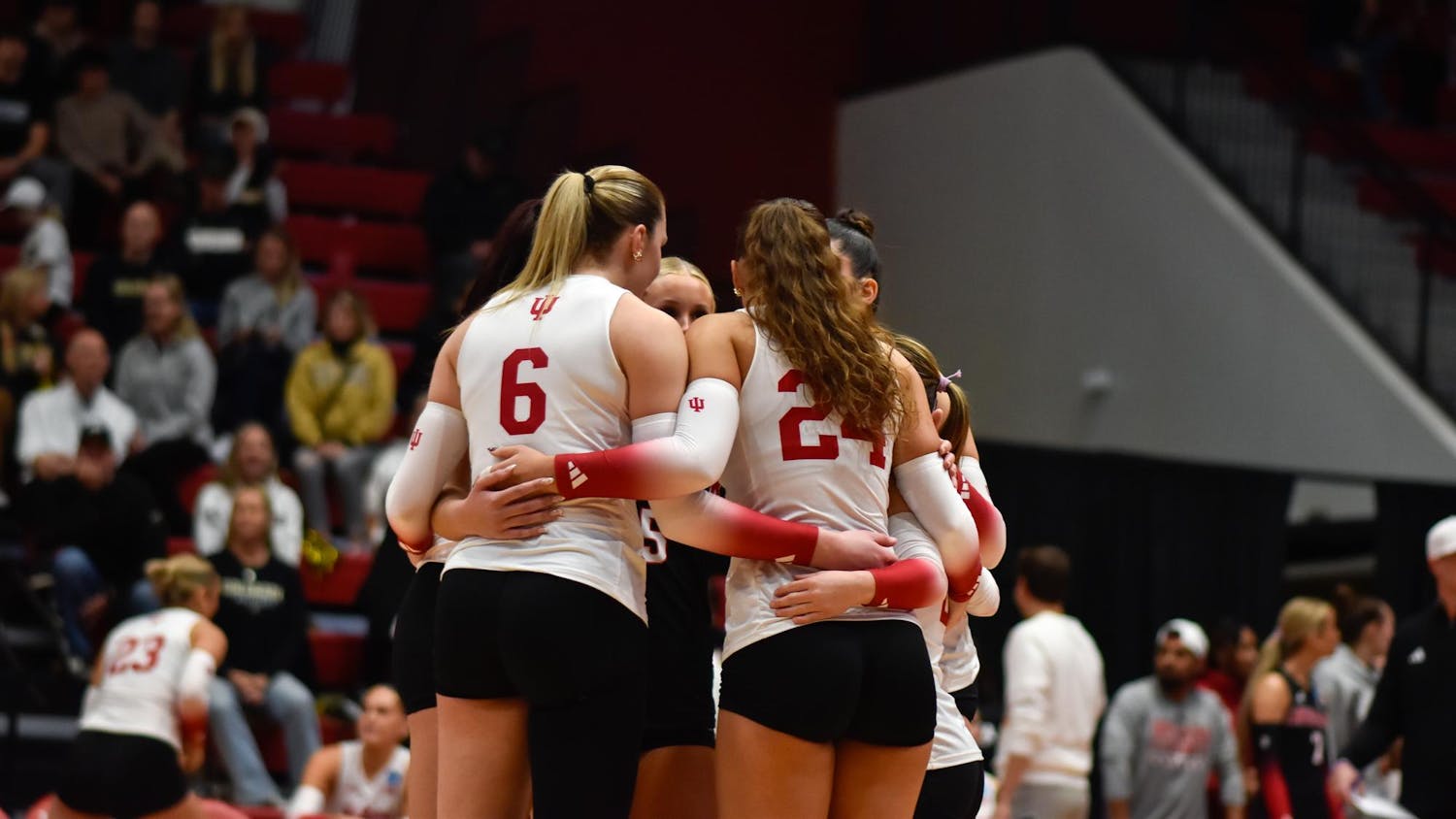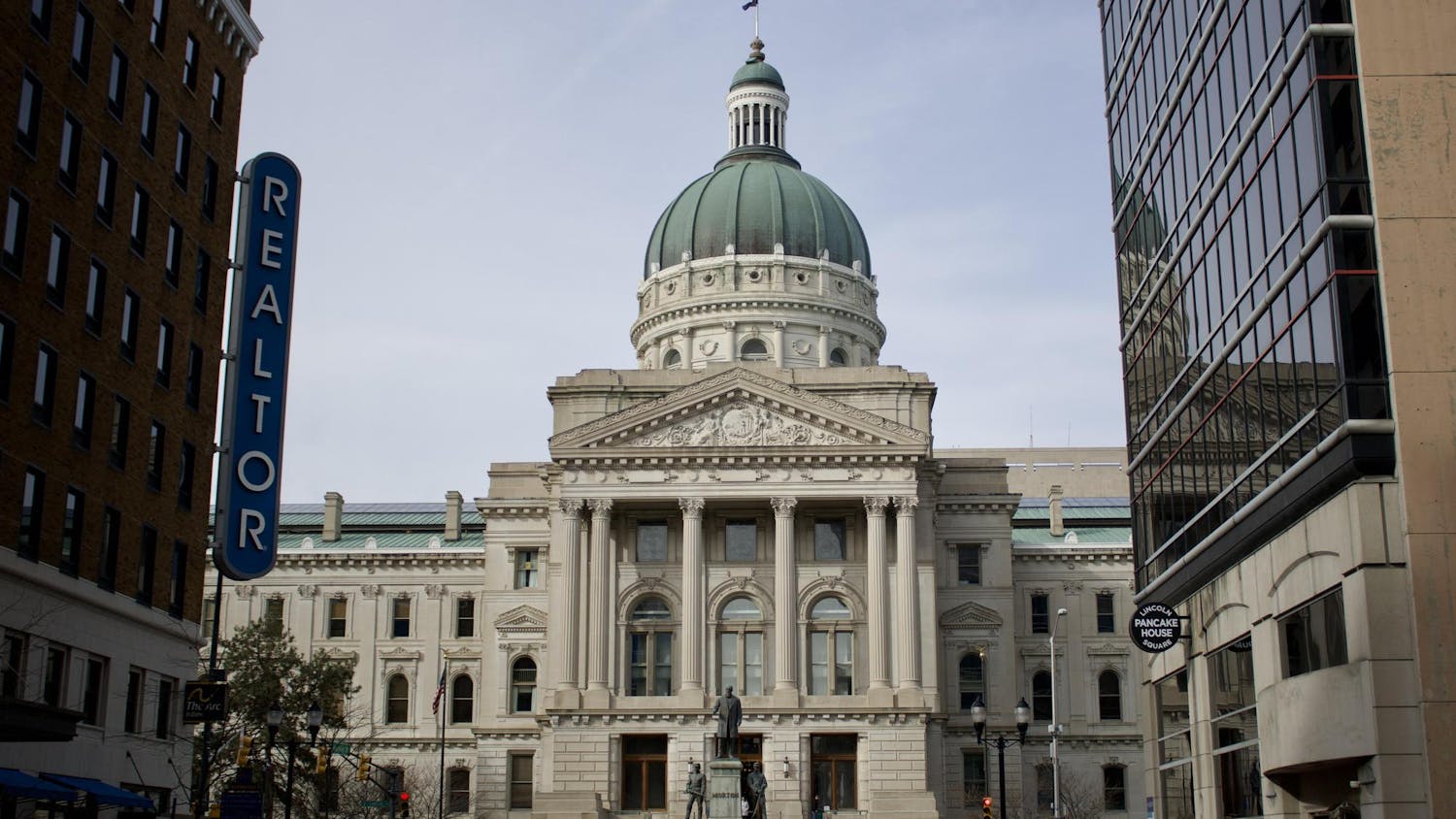No Space For Hate, a local group working to fight white supremacy, released a report in July about white supremacist recruitment at IU. The report found incidents of racism and white supremacy have rapidly increased on campus since 2017. NSFH predicts racist violence will continue to escalate unless it is aggressively, proactively and institutionally combatted.
There are more than 10 highly active white supremacist groups operating in and around IU’s campus, NSFH found. Bloomington is a strategic recruitment hub, and NSFH said white supremacist recruitment efforts have gone largely unimpeded by both the university and the police.
White supremacist activity has “exploded” since 2017, when Identity Evropa members flyered IU’s campus, and is continuing to intensify, said RG Reynolds, a researcher at NSFH. Identity Evropa placed fliers on the doors of faculty of color, indicating white supremacist groups were surveilling and tracking them.
The report made recommendations to help IU mitigate these problems and protect students. These recommendations were presented to the university this summer, but it is unclear whether and to what extent each will be implemented.
Kathy Adams-Riester, associate vice provost for student affairs, said the university is taking action on all of the recommendations in the report, but different ones are in different stages of development. When asked, Adams-Riester did not elaborate on any specifics, saying much of this was not in her department’s control.
“I can’t stress enough how clear it is that Jim Crow did not leave the state of Indiana, and that the city of Bloomington is the epicenter of [another] rising,” Reynolds said.
No Space For Hate’s recommendations
NSFH’s report emphasized how urgent the problem of white supremacy on campus is, and that treating white supremacist speech like other forms of speech is irresponsible because it could lead to violence.
The group’s first recommendation is to prioritize the physical safety of students, especially students who belong to targeted groups such as Black and Indigenous people, other people of color, LGBTQ people, disabled people and some religious communities. The physical safety of all of these groups is jeopardized by the presence of white supremacists and other far-right groups.
NSFH also recommended a mandatory anti-racist curriculum, which the university appears to be working toward. It recommended an increase in mental health resources for those who experience racism on campus and for Counseling and Psychological Services counselors to receive training on how to counsel students who are members of hate groups. While the Pandemic Health Disparities Fund has mental health resources for students of color, it does not address the anti-racist dimensions of NSFH’s recommendation.
Various anti-racist initiatives on campus may be fulfilling parts of NSFH’s eight recommendations, but most do not address the deep, structural issues that the recommendations urge the university to address. While there are various levels of action being taken on each of the suggestions, Adams-Riester said any concrete steps remain largely unclear.
Adams-Riester also said not all university anti-racist initiatives stem from the report. IU spokesperson Chuck Carney pointed out IU President Michael McRobbie took some tangible steps to implement anti-racist initiatives before the report’s release.
With regard to NSFH’s recommendation that the university not allow scholars with ties to white nationalist organizations or whose work propagates racist ideas on campus, Adams-Riester said, “We have this thing called the First Amendment that allows people to come and share different types of ideas.”
“There are parties across IU that have signaled a strong desire to implement all of the recommendations that we have made,” Reynolds said. “The question is whether that is possible. And the question is whether there is enough political will from people in the highest echelons of the university administration.”
NSFH’s report emphasized the difference between free speech and hate speech. Although hate speech is protected by the First Amendment, white supremacist propaganda and recruitment are violent at their core, and white supremacist rhetoric seeks to reinforce racial hierarchy.
Racist incidents on the rise, likely underreported
Occurrences of racism are on the rise on campuses nationwide, and NSFH’s report showed IU is part of this trend. In 2019 alone, there were at least seven incidents of white supremacist propaganda on IU’s campus or in its digital spaces.
Instructors, especially instructors of color, have reported an increase in racist incidents in the classroom since 2017. NSFH’s report found faculty, staff and students may be underreporting incidents of bias because of a lack of clarity about how reporting works and what its outcomes are.
Since IU moved classes and events largely to Zoom in March, there have been multiple incidents of racist Zoombombing. The first was the IUSG town hall that was shut down in April when Zoombombers interrupted the meeting with racial slurs and pornography.
Since the beginning of the fall 2020 semester, there have been similar incidents of Zoombombing targeting Black and Muslim student organizations. The university said it is investigating these events.
“These are neither individual incidents nor ‘a few bad apples’ rather, we contend they evidence a pattern of white supremacist sentiment that must be addressed at the institutional level,” NSFH's report reads.
Potential for violence at IU
NSFH predicts racist Zoombombing will continue and far-right groups will increase their efforts to dox faculty, staff and students.
Since the death of George Floyd in May, which sparked a national upheaval on racism and police brutality, there have been 66 vehicular attacks on Black Lives Matter protesters and related political rallies and protests, according to the report. Four of those attacks were in Indiana, and two were in Bloomington.
“The university needs to move on this before this becomes a serious outbreak of violence,” Reynolds said. “There will be violence. We have already seen it.”
With the election coming up, the university needs to closely monitor the potential threat of white supremacist activity on campus, she said.
Reynolds expressed concern about disruption of on-campus events that have to do with voting, voter registration or addressing concerns about the election. She predicted more right-wing protests will occur, and individuals might carry weapons and provoke the kind of conflicts that have been seen at prior protests.
The explicit sexual harassment of protesters who are women and students who are women by right-wing protesters is also a problem Reynolds saw in Bloomington and expects will continue.
Investigating IU police
The report cited FBI evidence of connections between the police and white supremacist groups nationwide. Given this evidence, NSFH recommended IU conduct an investigation to ensure the IU Police Department does not have officers who are members of hate groups or white supremacist groups. It also recommended IU establish civilian oversight for IUPD.
IUPD lacks transparency and has no external oversight, Reynolds said. When police organizations don’t vet candidates for possible connections to white supremacist groups, she said, there is an increased possibility of racist bias and violence.
Carney pointed to the Chief Community Advisory Board as one of many things IUPD has done in regard to issues of race and bias. However, this board has no oversight, investigative or disciplinary power, and its meetings are closed to board members.
As for off-campus policing, Bloomington Police Department Chief Mike Diekhoff denied the presence of systemic racism within his department. He later said that he misspoke, but he has shot down the idea of vetting candidates for ties to white supremacist groups. This attitude is a cause for concern for NSFH. In the organization’s experience, police across central and southern Indiana have not taken white supremacy seriously.
“It is crucial that we not allow people who have been maintaining covert relationships with white supremacist organizations and with webpages that promote violence against activists, against Black people and against Muslims into a space where they are allowed to use deadly force,” Reynolds said.
White supremacist recruitment on campus
The Ku Klux Klan and the Proud Boys are likely the best-known white supremacist recruiters on campus, but white students are being recruited by more than 10 white supremacist groups and militias. A growing number of white students identify as members of these groups, and some have attempted to recruit their classmates. NSFH recommended IU expel these students.
The report also drew attention to Turning Point USA. TPUSA is a right-wing group that is not classified as white supremacist, but some of its leaders have expressed public support for members of the boogaloo movement, which is a militia movement that seeks to replace the American government with a white fascist ethnostate.
TPUSA is funded by the Koch Brothers Foundation, which also donates substantial amounts to the Kelley School of Business. At least four members of TPUSA attend the Kelley School of Business, NSFH found.
NSFH recommended IU cut ties with the Koch Brothers Foundation and ensure TPUSA members understand that support for the boogaloo movement is support for domestic terrorism.
White supremacist recruitment at IU is usually relatively easy to identify, Reynolds said, but she provided some tips for students who want to know the signs.
A common tactic for white supremacist recruitment on campus is for someone in a suit to try to hand you a business card, Reynolds said. They might use terms like “our folk” or “our people” and appeal to the need to preserve Western culture and the superiority of Western civilization. They will use phrases that suggest they are interested in the creation of a white ethnostate and violence against marginalized groups, but they will deny that is their goal.
To identify symbols you should be on the lookout for in Bloomington specifically, NSFH published a flier showing the insignias for white supremacist groups that are active at and around IU.
Note: The report's data and terminology
The data in NSFH’s report came from public posts by members of white supremacist groups and accounts of individuals’ experiences on campus. These were used to determine the extent of the presence of the groups and who the major players are.
The NSFH research division also spoke to administrators to determine the threats on and around campus, something the group had not seen the university do.
In the report, white supremacist is used as an umbrella label that refers to individuals and groups that seek to elevate and maintain white racial dominance, but white supremacy is a deeper and more systemic phenomenon. White nationalist groups, which are one type of white supremacist group, seek the creation of a white ethnostate by segregation or genocide. This article uses the umbrella term white supremacist throughout.




